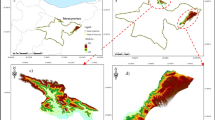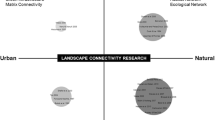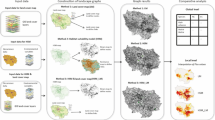Abstract
Connectivity of potential habitat patches has become essential for the biodiversity conservation and protection. In Multi Criteria Evaluation (MCE) of IDRISI software, Weighted Linear Combination (WLC) module facilitates to choose the potential habitat patches for connectivity analysis mainly based on the weights given through the Analytical Hierarchy Process (AHP) method. Digital Elevation Model, Slope, Disturbance Index layer, Road and natural vegetation layers are the different parameters considered for the WLC analysis along with the Biologcial Richness Layer. AHP results showed 0.05 consistency ratio. WLC generated outputs are applied in the graph theory based Conefor Sensinode 2.6 software. Integral Index of Connectivity (IIC) with special emphasis on each habitat’s importance value (dIIC: Integral Index of Connectivity importance value for each habitat patch in comparison with all the habitat patches of the entire study area based on network analysis and graph theory approach) are analyzed to understand the habitat patch connectivity. Perspective component chosen through dIIC served huge amount of information regarding the potential patches for further intensive field analysis. Spatial analyst tools of ArcGIS helped to find the paths between the chosen source and destination. The two paths generated from WLC and dIIC layer passed through the identified potential habitat patches (A, B, C and D). Thus, these two methods played important role in biodiversity conservation and maintenance of these potential patches. Decision support analysis through WLC, coupled with graph theory based dIIC facilitated to identify the potential patches and the corresponding path efficiently.






Similar content being viewed by others
References
Bhagwat, S. A., Willis, K. J., Birks, H. J. B., & Whittaker, R. J. (2008). Agroforestry: a refuge for tropical biodiversity? Trends in Ecology & Evolution, 23(5), 261–267.
Bodin, Ö., & Saura, S. (2010). Ranking individual habitat patches as connectivity providers: integrating network analysis and patch removal experiments. Ecological Modelling, 221(19), 2393–2405.
Bonissone, P. P., & Decker, K. S. (2013). Selecting uncertainty calculi and granularity: An experiment in trading-off precision and complexity. arXiv preprint arXiv:1304.3425.
Champion, H. G., & Seth, S. K. (1968). Revised forest types of India. New Delhi: Govt. Of India Publications.
DOS_DBT Manual (2008) Biodiversity characterization in landscape level using satellite remote sensing data and GIS, India.
Foltête, J. C., Clauzel, C., & Vuidel, G. (2012). A software tool dedicated to the modelling of landscape networks. Environmental Modelling & Software, 38, 316–327.
Foltête, J. C., Girardet, X., & Clauzel, C. (2014). A methodological framework for the use of landscape graphs in land-use planning. Landscape and Urban Planning, 124, 140–150.
Frazier, A. E., & Bagchi-Sen, S. (2015). Developing open space networks in shrinking cities. Applied Geography, 59, 1–9.
FSI. (2011). Forest survey of India. Dehradun: Ministry of Environment and Forestry.
Fu, W., Liu, S., Degloria, S. D., Dong, S., & Beazley, R. (2010). Characterizing the “fragmentation–barrier” effect of road networks on landscape connectivity: a case study in Xishuangbanna, Southwest China. Landscape and Urban Planning, 95(3), 122–129.
Gao, P., Kupfer, J. A., Guo, D., & Lei, T. L. (2013). Identifying functionally connected habitat compartments with a novel regionalization technique. Landscape Ecology, 28(10), 1949–1959.
Gerlach, G., & Musolf, K. (2000). Fragmentation of landscape as a cause for genetic subdivision in bank voles. Conservation Biology, 14(4), 1066–1074.
Henig, M. I., & Weintraub, A. (2006). A dynamic objective–subjective structure for forest management focusing on environmental issues. Journal of Multi-Criteria Decision Analysis, 14(1–3), 55–65.
Ido, M., & William, W. C. (2002). Modelling risk and uncertainty with the analytic hierarchy process. Journal of Multi-Criteria Decision Analysis, 11(2), 97–107.
Jayakumar, S., Arockiasamy, D. I., & Britto, S. J. (2002). Conserving forests in the Eastern Ghats through remote sensing and GIS—a case study in Kolli hills. Current Science, 82, 1259–1267.
Kangas, J. (1993). A multi-attribute preference model for evaluating the reforestation chain alternatives of a forest stand. Forest Ecology and Management, 59(3), 271–288.
Kangas, J., Kangas, A., Leskinen, P., & Pykäläinen, J. (2001). MCDM methods in strategic planning of forestry on state-owned lands in Finland: applications and experiences. Journal of Multi-Criteria Decision Analysis, 10, 257–271.
Levine, E. R., Ranson, K. J., Smith, J. A., Williams, D. L., Knox, R. G., Shugart, H. H., & Lawrence, W. T. (1993). Forest ecosystem dynamics: linking forest succession, soil process and radiation models. Ecological Modelling, 65(3), 199–219.
Leskinen, P. (2000). Measurement scales and scale independence in the analytic hierarchy process. Journal of Multi-Criteria Decision Analysis, 9(4), 163–174.
Loro, M., Ortega, E., Arce, R. M., & Geneletti, D. (2015). Ecological connectivity analysis to reduce the barrier effect of roads. An innovative graph-theory approach to define wildlife corridors with multiple paths and without bottlenecks. Landscape and Urban Planning, 139, 149–162.
Malekmohammadi, B., & Rahimi, B. L. (2014). Ecological risk assessment of wetland ecosystems using multi criteria decision making and geographic information system. Ecological Indicators, 41, 133–144.
Mendoza, G. A., & Prabhu, R. (2000). Development of a methodology for selecting criteria and indicators of sustainable forest management: a case study on participatory assessment. Environmental Management, 26(6), 659–673.
Mendoza, G. A., & Sprouse, W. (1989). Forest planning and decision making under fuzzy environments: an overview and illustration. Forest Science, 35(2), 481–502.
Natarajan, D., Britto, S. J., Balaguru, B., Nagamurugan, N., Soosairaj, S., & Arockiasamy, D. I. (2004). Identification of conservation priority sites using remote sensing and GIS—a case study from Chitteri hills, Eastern Ghats, Tamil Nadu. Current Science, 86, 1316–1323.
NRSA. (2007). Biodiversity characterisation at landscape level in Eastern Ghats and East coast using satellite remote sensing and geographic information system. Department of Space, National Remote Sensing Agency, ISBN: 978-81-7525-877-8.
Parthasarathy, N., & Sethi, P. (1997). Tree and liana species diversity and population structure in a tropical dry evergreen forest in south India. Tropical Ecology, 38, 19–30.
Pascual-Hortal, L., & Saura, S. (2006). Comparison and development of new graph-based landscape connectivity indices: towards the priorization of habitat patches and corridors for conservation. Landscape Ecology, 21(7), 959–967.
Pérez-Hernández, C. G., Vergara, P. M., Saura, S., & Hernández, J. (2015). Do corridors promote connectivity for bird-dispersed trees? The case of Persea lingue in Chilean fragmented landscapes. Landscape Ecology, 30(1), 77–90.
Pukkala, T., & Kangas, J. (1996). A method of integrating risk and attitude toward risk into forest planning. Forest Science, 42, 198–205.
Reddy, C. S., Pattanaik, C., Mohapatra, A., & Biswal, A. K. (2007). Phytosociological observations on tree diversity of tropical forest of Similipal Biosphere Reserve, Orissa, India. Taiwania, 52, 352–359.
Reddy, C. S., Shilpa, B., Giriraj, A., Reddy, K. N., & Rao, K. T. (2008). Structure and floristic composition of tree diversity in tropical dry deciduous forest of Eastern Ghats, Southern Andhra Pradesh, India. Asian Journal of Scientific Research, 1, 57–64.
Reddy, C. S., Babar, S., Amarnath, G., & Pattanaik, C. (2011). Structure and floristic composition of tree stand in tropical forest in the Eastern Ghats of northern Andhra Pradesh, India. Journal of Forestry Research, 22(4), 491–500.
Reddy, C. S., Krishna, P. H., Anitha, K., Joseph, S. (2012). Mapping and inventory of forest fires in Andhra Pradesh, India: current status and conservation needs. ISRN Forestry, 2012.
Roy, P. S., Behera, M. D., Murthy, M. S. R., Roy, A., Singh, S., Kushwaha, S. P. S., et al. (2015). New vegetation type map of India prepared using satellite remote sensing: Comparison with global vegetation maps and utilities. International Journal of Applied Earth Observation and Geoinformation, 39, 142--159.
Roy, A., Shanthala, D. B. S., Debnath, B., & Murthy, M. S. R. (2010). Geospatial modelling for identification of potential ecological corridors in Orissa. Journal of the Indian Society of Remote Sensing, 38(3), 387–399.
Rubio, L., Bodin, Ö., Brotons, L., & Saura, S. (2015). Connectivity conservation priorities for individual patches evaluated in the present landscape: how durable and effective are they in the long term? Ecography, 38, 782–791.
Saaty, R. W. (1987). The analytic hierarchy process—what it is and how it is used. Mathematical Modeling, 9(3), 161–176.
Saura, S., & Pascual-Hortal, L. (2007a). CONEFOR SENSINODE 2. 2 user’s manual: Software for quantifying the importance of habitat patches for maintaining landscape connectivity through graphs and habitat availability indices. Leida: University of Leida.
Saura, S., & Pascual-Hortal, L. (2007b). A new habitat availability index to integrate connectivity in landscape conservation planning: comparison with existing indices and application to a case study. Landscape Urban Planning, 83, 91–103.
Saura, S., Torné, J. (2012). CONEFOR 2.6 User manual. Quantifying the importance of habitat patches and links for maintaining or enhancing landscape connectivity through spatial graphs and habitat availability (reachability) metrics, http://conefor.org/files/usuarios/ManualConefor26.pdf.
Schmoldt, D. L., & Peterson, D. L. (2000). Analytical group decision making in natural resources: methodology and application. Forest Science, 46, 62–75.
Schmoldt, D. L., Peterson, D. L., & Silsbee, D. G. (1994). Developing inventory and monitoring programs based on multiple objectives. Environmental Management, 18(5), 707–727.
Schmoldt, L. D., Kangas, J., Mendoza, G. A., & Pesoner, M. (2001). The analytic hierarchy process in natural resource and environmental decision making. Kluwer Academic Publishers.
Schroth, G. (Ed.). (2004). Agroforestry and biodiversity conservation in tropical landscapes. Island Press.
Shanthala, D. B. S., Murthy, M. S. R., Bijan, D., & Jha, C. S. (2013). Forest patch connectivity diagnostics and prioritization using graph theory. Ecological Modelling, 251, 279–287.
Shiliang, L., Dong, Y., Deng, L., Qi, L., Haidi, Z., & Dong, S. (2014). Forest fragmentation and landscape connectivity change associatedwith road network extension and city expansion: a case study in theLancang River Valley. Ecological Indicators, 36, 160–168.
Wang, S. J., Ma, H., & Zhao, Y. B. (2014). Exploring the relationship between urbanization and the eco-environment—a case study of Beijing–Tianjin–Hebei region. Ecological Indicators, 45, 171–183.
Wenstøp, F., & Seip, K. (2001). Legitimacy and quality of multi-criteria environmental policy analysis: a meta analysis of five MCE studies in Norway. Journal of Multi Criteria Decision Analysis Special Issue Multicriteria Analysis for Environmental Management, 10(2), 53–64.
Acknowledgments
We sincerely thank Director, National Remote Sensing Centre (NRSC) and Deputy Director, Remote Sensing Application (NRSC) for offering the opportunity to work on this innovative idea through “DOS-DBT Project: Biodiversity Characterization at the Landscape Level (BCLL) using Satellite Remote Sensing and GIS”. We thank Dr P.S Roy (DOS-DBT Project Director) for his consistent encouragement throughout the project work. Thanks are due to all the Scientists and Research scholars of this Project (Phase II and III) for their valuable field data information and suggestions. We acknowledge the editor and the anonymous reviewers for the helpful suggestions on our manuscript.
Author information
Authors and Affiliations
Corresponding author
About this article
Cite this article
Shanthala Devi B. S, Murthy, M.S.R., Bijan, D. et al. Identification of Potential Habitat Patches for Connectivity Using Weighted Linear Combination (WLC) and Integral Index of Connectivity (IIC) at East Godavari District, Andhra Pradesh, India. J Indian Soc Remote Sens 44, 385–394 (2016). https://doi.org/10.1007/s12524-015-0508-7
Received:
Accepted:
Published:
Issue Date:
DOI: https://doi.org/10.1007/s12524-015-0508-7




